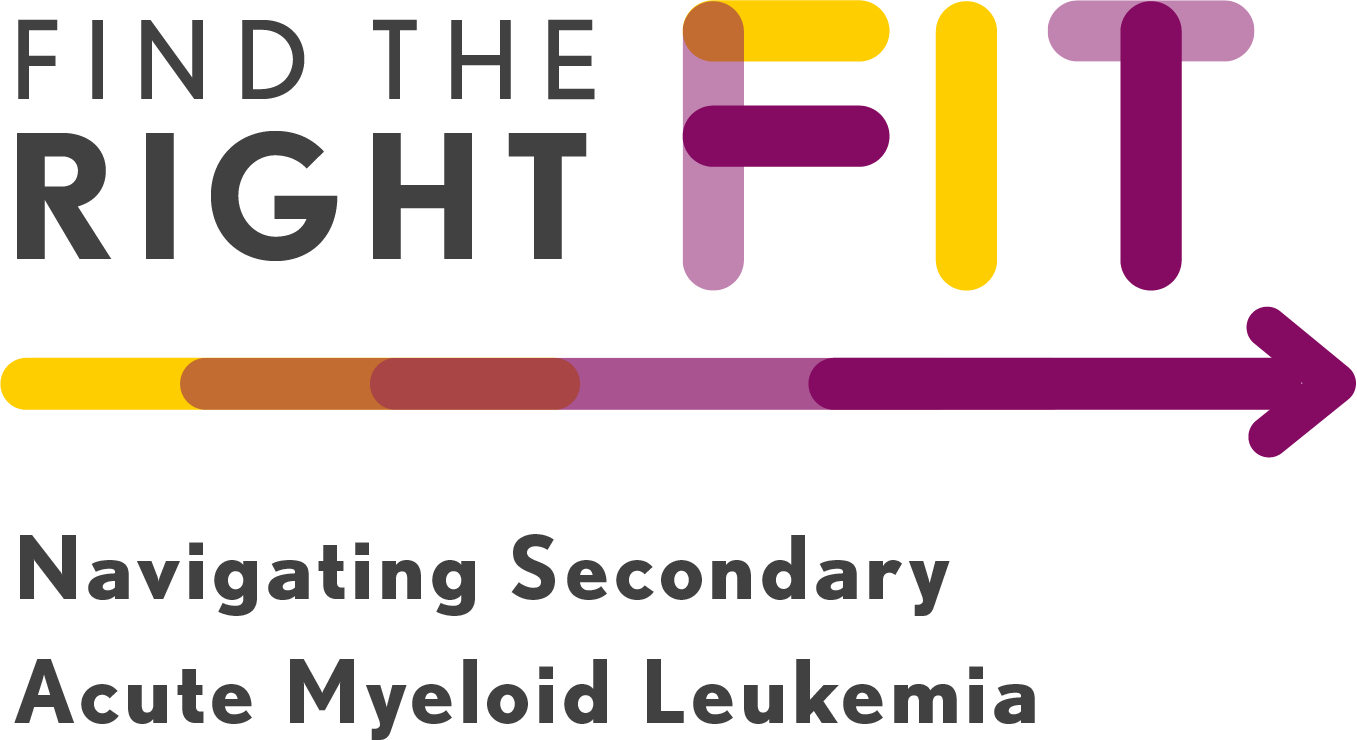The idea of treating cancer may immediately bring to mind words like chemotherapy and radiation, or maybe even immunotherapy, but what do these really mean? Are they used for the treatment of sAML?
Here’s a brief overview of the science behind treating AML, which may help to prepare you and your loved ones for conversations.
Secondary AML (sAML) is not a one-size-fits-all diagnosis. Like a fingerprint, your experience with sAML is unique. This cancer is more common in older people who are more likely to have preexisting health conditions.1 It is considered difficult to treat and often requires specialized treatment.1,2
Because sAML can quickly worsen, chemotherapy is often the treatment approach to stop or slow the growth of cancer.3,4 The goals of chemotherapy are to kill as many cancer cells as possible and shrink tumors that are causing pain and other problems.4
You may be treated with high-dose or high-intensity chemotherapy, which is a more aggressive strategy.5 If your body is not able to tolerate high-intensity chemotherapy, or if you have preexisting health conditions, your doctor may suggest low-dose or low-intensity chemotherapy, or drugs called hypomethylating agents (HMAs).1,6
HMAs stop your body from producing cancer cells by interrupting the cell production process in your deoxyribonucleic acid (DNA).7 Given their balance between efficacy and moderate toxicity, these agents are a treatment option for older sAML patients who are not eligible for intensive therapies.1,8
There are two main types of HSCT:12
- ALLOGENEIC, meaning the patient requires a donor to supply stem cells.
- AUTOLOGOUS, meaning the stem cells are harvested from the patient.
If the sAML responds well to high-intensity chemotherapy, you may be a candidate for a hematopoietic stem cell transplant (HSCT).6,9
An HSCT helps restore a healthy supply of the blood-forming cells in the bone marrow that were destroyed by chemotherapy.10 This process most commonly requires stem cells from the bone marrow of a donor.9 Although a sibling match has been heavily relied on in the past, the donor does not have to be related to you. In fact, older patients typically find matches on the National Bone Marrow Registry rather than from relatives.9
An sAML patient’s eligibility for an HSCT depends on several factors including:11
- General health and performance status
- Disease state factors
- Age
- Comorbidities
- Previous treatments
Since sAML requires a specialized approach and can spread quickly, it is important to discuss options with your doctor to identify a treatment option as soon as possible.1-3
1 Cheung E, Perissinotti AJ, Bixby DL, et al. The leukemia strikes back: a review of pathogenesis and treatment of secondary AML. Ann Hetamol. 2019;98(3):541-559.
2 DiNardo CD, Cortes JE. Mutations in AML: prognostic and therapeutic implications. Hematology Am Soc Hematol Educ Program. 2016;1:348–355.
3 National Cancer Institute. Adult acute myeloid leukemia treatment (PDQ®) – patient version. https://www.cancer.gov/types/leukemia/patient/adult-aml-treatment-pdq. Updated March 6, 2020. Accessed May 13, 2020.
4 National Cancer Institute. Chemotherapy to treat cancer. https://www.cancer.gov/about-cancer/treatment/types/chemotherapy. Updated April 29, 2015. Accessed May 13, 2020.
5 Ossenkoppele G, Montesinos P. Challenges in the diagnosis and treatment of secondary acute myeloid leukemia. Crit Rev Oncol Hematol. 2019;138:6-13.
6 Wang ES. Treating acute myeloid leukemia in older adults. Hematology Am Soc Hematol Educ Program. 2014;(1):14-20.
7 Cruijsen M, Lübbert M, Wijermans P, et al. Clinical results of hypomethylating agents in AML treatment. J Clin Med. 2015;4(1):1-17.
8 Schroeder T, Rautenberg C, Haas R, et al. Hypomethylating agents after allogeneic blood stem cell transplantation. Stem Cell Investig. 2016;3:84.
9 Lipoff JJ, Loh KP, O’Dwyer K, Liesveld JL. Allogeneic hematopoietic cell transplantation for older adults with acute myeloid leukemia. Cancers (Basel). 2018;10(6):179.
10 Felfly H, Haddad GG. Hematopoietic stem cells: potential new applications for translational medicine. J. Stem Cells. 2014;9(3):163-97.
11 Anasetti, C. What are the most important donor and recipient factors affecting the outcome of related and unrelated allogeneic transplantation? Best Pract Res Clin Haematol. 2008;21(4):691-697.
12 National Cancer Institute. NCI dictionary of cancer terms. https://www.cancer.gov/publications/dictionaries/cancer-terms. Accessed May 13, 2020.
